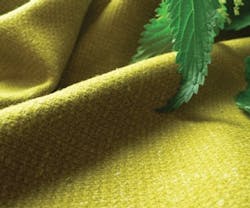Sting By CAMIRA FABRICS
Although the Textiles category of these awards doesn't carry the prefix "Innovative," this year's winner is certainly a standout example of revolutionary product design. Sting is a unique collaboration between industry and academia, with Camira Fabrics spearheading a U.K. government-funded four-year project in conjunction with a leading U.K. university to make a sustainable textile from wool and nettles. The end product is a natural textile made from annually renewable raw material inputs which are also biodegradable.
Sting is an ingenious environmental upholstery fabric whose key raw material input is an innovative natural fiber derived from bast fiber plants called nettles, and is the only wool-nettle blend fabric for commercial interiors available in the world today. It also meets all Association of Contract Textiles (ACT) standards for heavy-duty contract use. The fabric aesthetic is designed to exhibit its natural rustic charm in a fancy hopsack with a soft, tasteful color palette inspired by the English countryside and hedgerows.
Sting's energy and CO2 footprints are substantially reduced compared to petro-chemical synthetic fabrics. The dyewares used are also EU REACH approved (European Union program for the Registration, Evaluation, Authorization and restriction of Chemicals). No toxic emissions are given off to either sewer or air during manufacturing.
Sting achieves the highest level of inherent flame retardancy of any natural fiber fabric ever made (without additional fire resistance treatment). This is due to the charring properties of wool and the naturally occurring silica in the nettle fiber, which combine to create a barrier to flaming which then self-extinguishes.
Camira Fabrics
(317) 484-0305
www.camirafabrics.com
New mechanical decortication equipment was specially developed for this textile (decortication is the process of separating the nettle fiber from the bark and woody core). This overcomes the environmental issues—in particular water, chemical and enzyme use—associated with traditional bast fiber retting processes. The nettle stem yields 15 percent fiber, with the remaining woody remnants being sold on as biodegradable animal bedding.
The product captured the judges' attention by putting natural, rapidly renewable raw materials from plants and animals at the top of the environmental agenda, shifting focus away from finite, petro-chemical derivatives from both virgin and recycled supplies. They gave Sting high marks for its comprehensive energy and CO2 reduction considerations, its reuse and durability, Life Cycle Analysis and social equity components.
